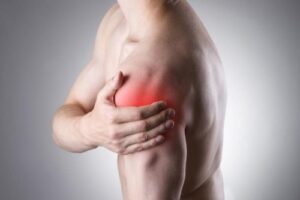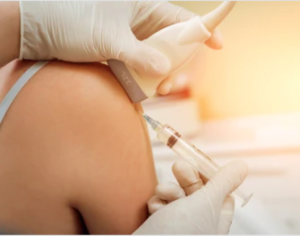Introduction
Shoulder pain is a common ailment that can significantly hinder daily activities and diminish one’s quality of life. Whether it’s due to overuse, injury, or degeneration, finding effective treatment is crucial. Platelet-Rich Plasma (PRP) with Prolotherapy is emerging as a promising option for addressing shoulder pain. In this blog, we’ll explore the indications, mechanisms of action, and the use of image-guided procedures in the context of PRP and Prolotherapy for shoulder pain.

Understanding Shoulder Pain
The shoulder is a complex joint with a wide range of motion. This complexity makes it susceptible to various types of injuries and conditions, including rotator cuff tears, tendinopathy, bursitis, and osteoarthritis. Chronic shoulder pain can be particularly challenging to manage and often requires comprehensive treatment approaches.
Indications for PRP with Prolotherapy in Shoulder Pain
- Rotator Cuff Tendinopathy : One of the most common shoulder conditions, rotator cuff tendinopathy, involves damage or degeneration of the tendons that connect the muscles to the bones in the shoulder. Research, such as a review published in Cureus in 2022, suggests that PRP injections can be effective in managing rotator cuff tendinopathy.
- Osteoarthritis : Shoulder osteoarthritis results from the gradual breakdown of the cartilage in the shoulder joint. PRP and Prolotherapy may help alleviate pain and potentially slow down the progression of osteoarthritis. While the focus is often on knee and hip osteoarthritis, the shoulder can also benefit from these therapies.
- Tendinopathies : PRP and Prolotherapy have shown promise in treating various shoulder tendinopathies, including biceps tendinopathy and supraspinatus tendinopathy.
- Ligament Injuries : Injuries to the ligaments supporting the shoulder joint, such as the acromioclavicular (AC) joint, can also lead to chronic pain. PRP and Prolotherapy can aid in the healing of these ligaments.
- Recurrent Shoulder Dislocations : For individuals prone to recurrent shoulder dislocations, strengthening the shoulder’s stabilizing structures through PRP and Prolotherapy can be beneficial in preventing further dislocations.

Mechanism of Action on Healing
Platelet-Rich Plasma (PRP)
PRP is derived from the patient’s blood, processed to concentrate the platelets and growth factors. When injected into the affected area of the shoulder, PRP promotes healing through several mechanisms:
- Stimulating Collagen Production : PRP enhances the production of collagen, a crucial protein for tendon and ligament strength.
- Reducing Inflammation : PRP’s anti-inflammatory properties help to calm the inflammatory response contributing to pain.
- Proliferation of Stem Cells : PRP encourages the migration and proliferation of stem cells to the injured area, aiding in tissue repair.
Prolotherapy
Prolotherapy, short for proliferative therapy, involves injecting a solution, often dextrose, into the damaged or weakened ligaments and tendons. This solution irritates the tissues, stimulating a natural healing response. The mechanisms of action of Prolotherapy include:
- Activation of Fibroblasts : Fibroblasts are key cells in tissue repair. Prolotherapy activates fibroblasts to produce collagen and repair damaged tissues.
- Strengthening Ligaments and Tendons : By promoting collagen synthesis and tissue remodeling, Prolotherapy strengthens the ligaments and tendons surrounding the shoulder joint.
Use of Image-Guided Procedures
Precise injection placement is critical for the effectiveness of PRP and Prolotherapy. Image-guided procedures, such as ultrasound or fluoroscopy, ensure that the injections target the precise location of the injury or degeneration. This accuracy enhances the likelihood of positive outcomes and minimizes the risk of complications.

Conclusion
Shoulder pain can significantly impact an individual’s quality of life, but emerging treatments like Platelet-Rich Plasma with Prolotherapy offer hope for effective pain relief and improved shoulder function. The indications for these therapies in shoulder pain encompass a range of conditions, from tendinopathies to osteoarthritis. Their mechanisms of action promote natural healing processes, including collagen production and reduced inflammation. Moreover, the use of image-guided procedures ensures the accuracy of injections, enhancing the likelihood of successful outcomes.
If you’re suffering from chronic shoulder pain, consult with a Chronic Pain Specialist such as AT ALLEVIATE, who specialize in regenerative medicine to determine if Platelet-Rich Plasma with Prolotherapy is a suitable treatment option for your specific condition.
REFERENCES
- Bhan K, Singh B. Efficacy of Platelet-Rich Plasma Injection in the Management of Rotator Cuff Tendinopathy: A Review of the Current Literature. Cureus. 2022 Jun 20;14(6):e26103. doi: 10.7759/cureus.26103.
- Schneider A, Burr R, Garbis N, Salazar D. Platelet-rich plasma and the shoulder: clinical indications and outcomes. Curr Rev Musculoskelet Med. 2018 Dec;11(4):593-597. doi: 10.1007/s12178-018-9517-9.
- Image taken from https://www.verywellhealth.com/shoulder-pain-2548793






